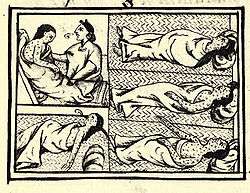1576 Cocoliztli epidemic

The cocoliztli epidemic of 1576 refers to millions of deaths in the territory of New Spain in present-day Mexico in 16th century attributed to one or more illnesses collectively called cocoliztli.
The cause of the epidemic remains unknown though it might have been an indigenous viral hemorrhagic fever, perhaps exacerbated by the worst droughts to affect that region in 500 years and living conditions for indigenous peoples of Mexico in the wake of European invasion.[1] Some historians have suggested it was typhus, measles, or smallpox, though the symptoms did not match.[2][3]
History

Cocoliztli epidemics usually occurred within two years of a major drought while another disease called "matlazahuatl" had appeared within two years of the rainy season.The epidemic in 1576 happened after a drought stretching from Venezuela to Canada.[5][6] The correlation between the drought and the disease seems to be that in the rains that followed the drought, populations of the Vesper mouse, a carrier of viral hemorrhagic fever, increased as conditions improved.[4] There have been 12 epidemics since thought to be of cocoliztli, with the largest being in 1545, 1576, 1736, and 1813.[6]
Etymology
The disease's name originated from the Nahuatl language word for "pest",[1] or disease, illness, and plague.The name lost this meaning when it became associated with this unnamed disease that killed Natives and Spaniards alike when it first appeared in 1545.[7]
Symptoms
According to Francisco Hernandez, a physician who witnessed the outbreak in 1576, symptoms included high fever, severe headache, vertigo, black tongue, dark urine, dysentery, severe abdominal and thoracic pain, head and neck nodules, neurologic disorders, jaundice, and profuse bleeding from the nose, eyes, and mouth; death frequently occurred in 3 to 4 days.[1]
References
- 1 2 3 Acuna-Soto, R; Stahle, DW; Cleaveland, MK; Therrell, MD (April 2002). "Megadrought and megadeath in 16th century Mexico.". Emerging Infectious Diseases. 8 (4): 360–2. doi:10.3201/eid0804.010175. PMC 2730237
 . PMID 11971767.
. PMID 11971767. - ↑ "La epidemia de cocoliztli de 1576" (PDF). Instituto Nacional de Antropología e Historia. Retrieved 30 November 2015.
- ↑ "Historia de las epidemias en el mexico antiguo" (PDF). Universidad Autónoma Metropolitana. Retrieved 28 November 2015.
- 1 2 ""Huey cocoliztli" en el México del siglo XVI: ¿una enfermedad emergente del pasado?". www.madrimasd.org. Retrieved 8 December 2015.
- ↑ "Cocoliztli y Matlazahuatl". www.zocalo.com.mx. Retrieved 6 November 2015.
- 1 2 "Fiebres hemorrágicas causa de muerte en las culturas originarias". www.ciudadania-express.com. Retrieved 6 December 2015.
- ↑ "Historia de las epidemias en el mexico antiguo" (PDF). Universidad Autónoma Metropolitana. Retrieved 28 November 2015.
External links
- "Megadeath in Mexico". discovermagazine.com. Retrieved 2015-11-28.
- "'Ebola' bug wiped out the Aztecs". The Guardian. Retrieved 2015-11-28.
- "Expert: Native disease killed Aztecs, not outsiders". chron.com. Retrieved 2015-12-05.